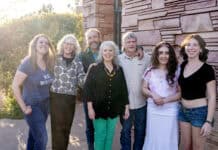On Thursday, May 17, Beth and Ross Hawkins, Ph.D., of the Hummingbird Society, a nonprofit organization focused on hummingbird education and conservation, gave a presentation at the Sedona Public Library titled “Hummingbirds: Source of joy and meaning.”
Larson Newspapers
________________
On Thursday, May 17, Beth and Ross Hawkins, Ph.D., of the Hummingbird Society, a nonprofit organization focused on hummingbird education and conservation, gave a presentation at the Sedona Public Library titled “Hummingbirds: Source of joy and meaning.”
“Hummingbirds are messengers between two worlds — heaven and Earth,” Beth Hawkins told the audience.
 A certified music therapist and award-winning nature photographer, she and her husband launched the Hummingbird Society in 1996 to teach people about hummingbirds and how to conserve them, she said.
A certified music therapist and award-winning nature photographer, she and her husband launched the Hummingbird Society in 1996 to teach people about hummingbirds and how to conserve them, she said.
Her fascination with hummingbirds began with her first encounter as a child at her grandfather’s cabin in Maine, she said.
Years later, she discovered she had a real passion for photographing them, which made sense. Her mother was also a bird photographer, so she was used to traveling the world to search for birds, she said.
According to Ross, hummingbirds are some of the most difficult animals to photograph.
“They move fast,” he said. “They’re here. They’re there. And you’ve got to have a big zoom to really get a closeup picture of them.”
After a few years of trying to push a standard camera beyond its limits, Ross scrapped his old equipment and started from scratch, he said. He and Beth got better cameras, started taking classes and did everything they could to learn about the hummingbirds they were searching for.
“These are very unusual birds with extreme characteristics,” Ross said.
They have an average wingbeat of about 40 to 50 per second, or 3,000 per minute, he said. That kind of speed requires a lot of energy, so they need to feed every 15 to 20 minutes during the day just to keep going.
They feed mainly on flower nectar and tend to prefer red flowers with little or no scent, he said. It helps them to avoid having to compete with insects.
To conserve their energy during the night, they voluntarily lower their metabolism and temperature. By entering a state of torpor, they reduce their need for food and they actually appear dead while they’re sleeping, Ross said.
They’re also sexually dimorphic, which means the male and female birds differ in appearance, Ross said. Many male hummingbirds, for example, have iridescent features, which are visible only from specific angles.
They’re able to position themselves to either accentuate their iridescent plumage to court females or camouflage themselves to hide from predators, he said.
Cats, roadrunners, other birds and even praying mantises are among their known predators, but their biggest threats are invasive plants that attack their food sources and human beings who destroy their habitats, Ross said.
Of the approximately 328 species of hummingbirds, which are found only in the Americas, 28 are endangered, he said. Most of the threatened species are native to Central and South America where communities are chopping down trees and plants to make room for livestock, he said.
In cooperation with other agencies, organizations and individuals, the Hummingbird Society is working aggressively to protect their habitats, Ross said. They’re currently working to raise money to buy and protect land in Honduras.
From their office in the Village of Oak Creek, the Hawkinses promote conservation efforts on behalf of hummingbirds. Memberships and donations to the Hummingbird Society are welcome at www.hummingbirdsociety.org.
The couple also recently opened the Sedona Hummingbird Gallery at 6560 Hwy. 179, Suite 214, in the La Plaza shopping center, in the Village of Oak Creek. The store features Beth Hawkins’ photography as well as jewelry and other hummingbird-related items. For more information, call 284-0339 or visit www.hummingbirdsociety.org or www.hummerlady.com.



















